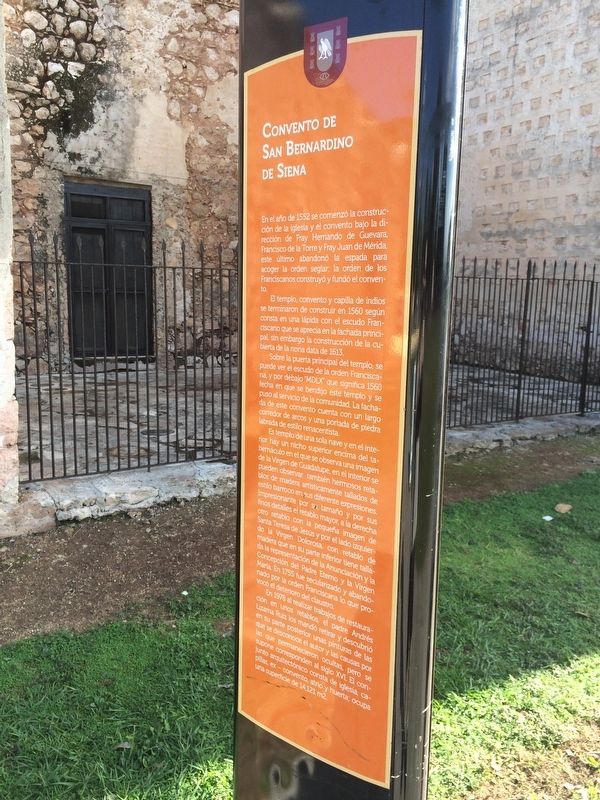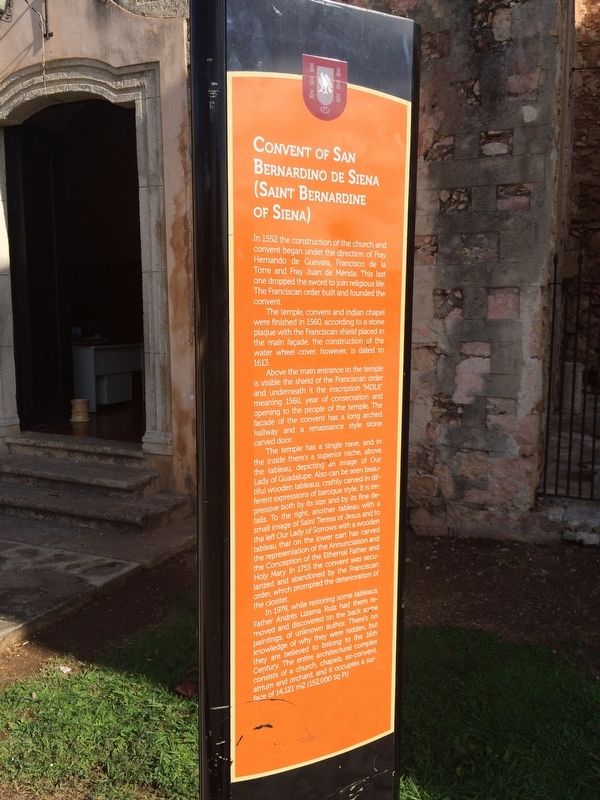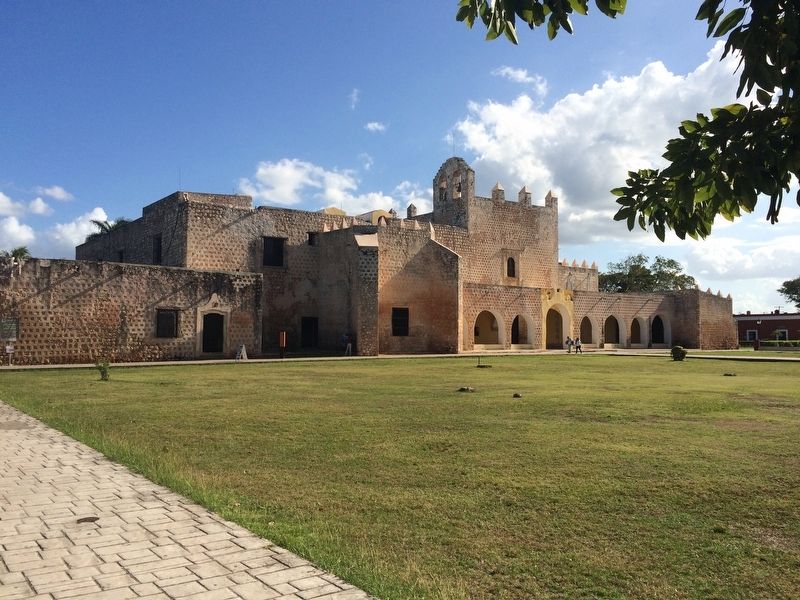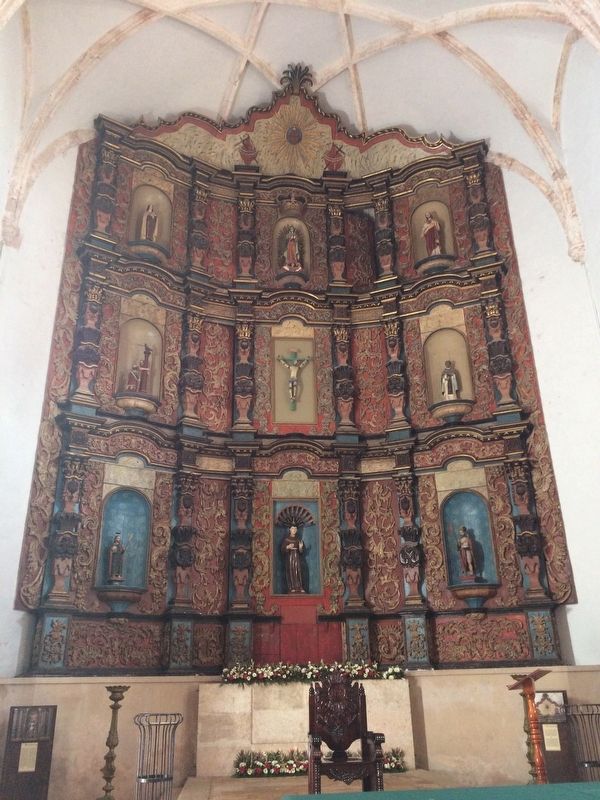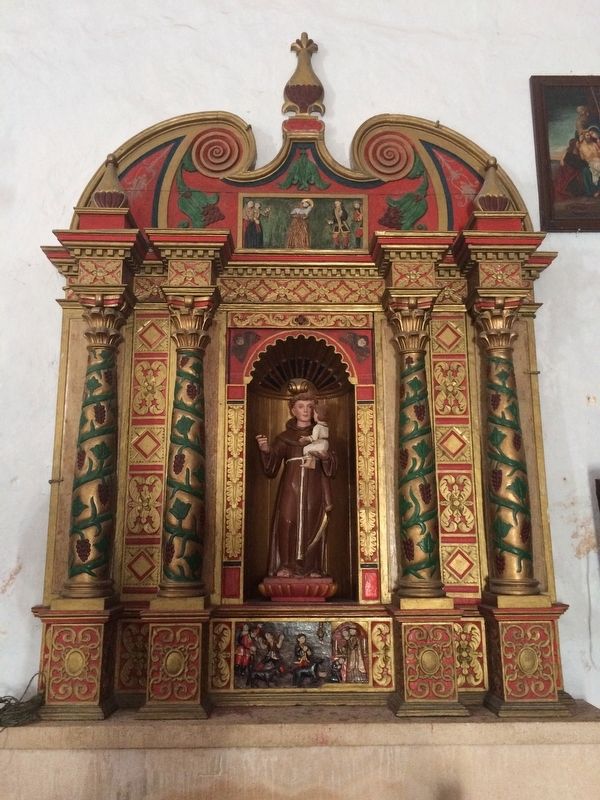Valladolid, Yucatán, Mexico — The Southeast (Yucatan Peninsula)
Convent of San Bernardino de Siena (Saint Berardine of Siena)
Inscription.
Convento de San Bernardino de Siena
En el año de 1552 se comenzó la construcción de la iglesia y el convento bajo la dirección de Fray Hernando de Guevara, Francisco de la Torre y Fray Juan de Mérida, este último abandonó la espada para acoger la orden seglar; la orden de los Franciscanos construyó y fundó el convento.
El templo, convento y capilla de indios se terminaron de construir en 1560 según consta en una lápida con el escudo Franciscano que se aprecia en la fachada principal, sin embargo la construcción de la cubierta de la noria data de 1613.
Sobre la puerta principal del templo, se puede ver el escudo de la orden Franciscana, y por debajo “MDLX” que significa 1560 fecha en que se bendijo este templo y se puso al servicio de la comunidad. La fachada de este convento cuento con un largo corredor de arcos y una portada de piedra labrada de estilo renacentista.
Es templo de una sola nave y en el interior hay un nicho superior encima del tabernáculo en el que se observa una imagen de la Virgen de Guadalupe, en el interior se pueden observar también hermosos retablos de madera artísticamente tallados de estilo barroco en sus diferentes expresiones. Impresionante por su tamaño y por sus finos detalles el retablo mayor, a la derecha otro retablo con la pequeña imagen de Santa Teresa de Jesús y por el lado izquierdo la Virgen Dolorosa, con retablo de madera que en su parte inferior tiene tallada la representación de la Anunciación y la Concepción del Padre Eterno y la Virgen María. En 1755 fue secularizado y abandonado por la orden Franciscana lo que provocó el deterioro del claustro.
En 1978 al realizar trabajos de restauración en unos retablos, el padre Andrés Lizama Ruiz los mandó retirar y descubrió en su parte posterior una pinturas de las que se desconoce el autor y las causas por las que permanecieron ocultas, pero se supone corresponden al siglo XVI. El conjunto arquitectónico consta de iglesia, capillas, ex-convento, atrio y huerta; ocupa una superficie de 14,121 m2.
English:
Convent of San Bernardino de Siena (Saint Berardine of Siena)
In 1552 the construction of the church and convent began under the direction of Fray Hernando de Guevara, Francisco de la Torre and Fray Juan de Mérida. This last one dropped the sword to join religious life. The Franciscan order built and founded the convent.
The temple, convent and indian chapel were finished in 1560, according to a stone plaque with the Franciscan shield placed in the main facade, the construction of the water wheel cover, however, is dated to 1613.
Above the main entrance to the temple is visible the shield of the Franciscan order and underneath
it the inscription “MDLX” meaning 1560, year of consecration and opening to the people of the temple. The
facade of the convent has a long arched hallway and a renaissance style stone carved door.
The temple has a single nave, and in the inside there’s a superior niche, above the tableau, depicting an image of Our Lady of Guadalupe. Also can be seen beautiful wooden tableaus, craftily carved in different expressions of baroque style. It is impressive both by its size and by its fine details. To the right, another tableau with a small image of Saint Teresa of Jesus and to the left Our Lady of Sorrows with a wooden tableau that on the lower part has carved the representation of the Annunciation and the Conception of the Ethernal Father and Holy Mary. In 1775 the convent was secularized and abandoned by the Franciscan order, which prompted the deterioration of the cloister.
In 1978 while restoring some tableaus, Father Andrés Lizama had them removed and discovered on the back some paintings, of unknown author. There’s no knowledge of why there were hidden, but they are believed to belong to the 16th Century. The entire architectural complex consists of a church, chapels, ex-convent, atrium and orchard, and it occupies a surface of 14,121 m2 (152,000 Sq Ft)
Topics. This historical marker is listed in these topic lists: Architecture
• Churches & Religion • Colonial Era • Native Americans. A significant historical year for this entry is 1552.
Location. 20° 41.172′ N, 88° 12.596′ W. Marker is in Valladolid, Yucatán. Marker can be reached from Calle 49. The marker is northeast of the entry to the convent. Touch for map. Marker is in this post office area: Valladolid YU 97780, Mexico. Touch for directions.
Other nearby markers. At least 8 other markers are within walking distance of this marker. Sisal Neighborhood (within shouting distance of this marker); Cenote “Sis-Há” (within shouting distance of this marker); The Waterwheel (within shouting distance of this marker); Mayan House (about 150 meters away, measured in a direct line); Road of the Friars (approx. 0.6 kilometers away); The Valladolid Artisans' Market (approx. 0.8 kilometers away); House of Governor Francisco Canton Rosado (approx. 0.9 kilometers away); The Crime of the Mayors (approx. 0.9 kilometers away). Touch for a list and map of all markers in Valladolid.
Credits. This page was last revised on March 4, 2017. It was originally submitted on March 4, 2017, by J. Makali Bruton of Accra, Ghana. This page has been viewed 182 times since then and 20 times this year. Photos: 1, 2, 3, 4, 5. submitted on March 4, 2017, by J. Makali Bruton of Accra, Ghana.
